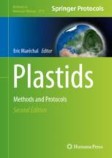Search
Search Results
-
Molecular landscape of etioplast inner membranes in higher plants
Etioplasts are photosynthetically inactive plastids that accumulate when light levels are too low for chloroplast maturation. The etioplast inner...

-
Diversification of Plastid Structure and Function in Land Plants
Plastids represent a largely diverse group of organelles in plant and algal cells that have several common features but also a broad spectrum of...
-
Light Perception and Transduction
Plants utilize light not only for photosynthesis but also as an environmental signal for many developmental processes. Plants are highly sensitive to...
-
Photocatalytic LPOR forms helical lattices that shape membranes for chlorophyll synthesis
Chlorophyll biosynthesis, crucial to life on Earth, is tightly regulated because its precursors are phototoxic
1 . In flowering plants, the enzyme...
-
Eine Blattzelle ist in mehrere metabolische Kompartimente unterteilt
In höheren Pflanzen erfolgt die Photosynthese hauptsächlich im Mesophyll, dem chloroplastenreichen Gewebe der Blätter. Abb. 1.1 zeigt ein...
-
CRY2 gene of rice (Oryza sativa subsp. indica) encodes a blue light sensory receptor involved in regulating flowering, plant height and partial photomorphogenesis in dark
Key messageOsiCRY2 is involved in light-regulated plant development and plays a role in regulating photomorphogenesis, plant height, flowering and...

-
Changes in plastid biogenesis leading to the formation of albino regenerants in barley microspore culture
BackgroundMicrospore embryogenesis is potentially the most effective method of obtaining doubled haploids (DH) which are utilized in breeding...

-
Cytological attributes of storage tissues in nematode and eriophyid galls: pectin and hemicellulose functional insights
Cell walls and protoplast may work together or distinctly in the establishment of the functional profiles of gall tissue compartments. This...

-

-
SCL, Encoding a Chloroplast Signal Recognition Particle Receptor, Affects Chlorophyll Synthesis and Chloroplast Development in Rice
Crop yield is largely determined by the solar energy utilization efficiency of photosynthesis; plants with long stay-green periods have greater total...

-
Chloroplast-to-chromoplast transition envisions provitamin A biofortification in green vegetables
The carotenoids available in food are vital dietary micronutrients for human health. Plants synthesize and accumulate different carotenoids in...

-
Albino Plant Formation in Androgenic Cultures: An Old Problem and New Facts
High frequency of albino plant formation in isolated microspore or anther cultures is a great problem limiting the possibility of their exploitation...
-
Inducible Pluripotent Suspension Cell Cultures (iPSCs) to Study Plant Cell Differentiation
Inducing the differentiation of specific cell type(s) synchronously and on-demand is a great experimental system to understand the sequential...
-
Ionic, not the osmotic component, is responsible for the salinity-induced inhibition of greening in etiolated wheat (Triticum aestivum L. cv. Mv Béres) leaves: a comparative study
Main conclusionGreening was partially (in 300 mM NaCl, CaCl 2 , 600 mM KNO 3 or KCl) or fully inhibited (in 600 mM NaCl, NaNO 3 or NaCl:KCl) by the...

-
A brief history of how microscopic studies led to the elucidation of the 3D architecture and macromolecular organization of higher plant thylakoids
Microscopic studies of chloroplasts can be traced back to the year 1678 when Antonie van Leeuwenhoek reported to the Royal Society in London that he...

-
Photocatalysis as the ‘master switch’ of photomorphogenesis in early plant development
Enzymatic photocatalysis is seldom used in biology. Photocatalysis by light-dependent protochlorophyllide oxidoreductase (LPOR)—one of only a few...

-
Plant carotenoids: recent advances and future perspectives
Carotenoids are isoprenoid metabolites synthesized de novo in all photosynthetic organisms. Carotenoids are essential for plants with diverse...

-
Ultrastructural aspects of metabolic pathways and translocation routes during mobilization of seed reserves in Acrocomia aculeata (Arecaceae)
Seeds of several palms are reserve-rich, and have a complex and poorly understood mobilization. The massive endosperm and embryo of Acrocomia aculeata ...

-
A Simple Method for Quantification of Protochlorophyllide in Etiolated Arabidopsis Seedlings
Etiolated seedlings accumulate the chlorophyll biosynthesis intermediate protochlorophyllide (Pchlide) and measuring Pchlide can be important for...
-
Endosymbiotic Origin of Chloroplasts in Plant Cells’ Evolution
AbstractThe theory of endosymbiotic origin of chloroplasts has become basal in present-day biology. In this regard, the emergence of eukaryotic...

